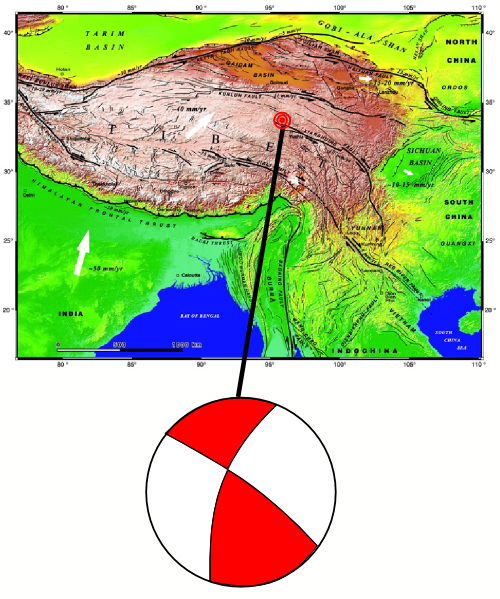![]() Late on Tuesday (or Wednesday morning local time) western China was shaken by a magnitude 6.9 earthquake. The focal mechanism, courtesy of the USGS, tells us that it occured on a strike-slip fault like the San Andreas fault and the Enriquillo fault in Haiti. In fact, it is located along the trace of the Xianshuihe fault system, one of several large strike slip faults that cut through this region. The focal mechanism can be interpreted as left-lateral (the two sides of the fault move left relative to each other) motion on a northwest-southeast trending fault, which is consistent with this earthquake being due to a rupture of a segment of the Xianshuihe fault.
Late on Tuesday (or Wednesday morning local time) western China was shaken by a magnitude 6.9 earthquake. The focal mechanism, courtesy of the USGS, tells us that it occured on a strike-slip fault like the San Andreas fault and the Enriquillo fault in Haiti. In fact, it is located along the trace of the Xianshuihe fault system, one of several large strike slip faults that cut through this region. The focal mechanism can be interpreted as left-lateral (the two sides of the fault move left relative to each other) motion on a northwest-southeast trending fault, which is consistent with this earthquake being due to a rupture of a segment of the Xianshuihe fault.

Focal mechanism and location of the 13 April earthquake in the Qinghai region of China. Map from Tapponnier et al. 2001 (Click for a slightly larger version).
The Xianshuihe fault is one of several similar faults spread over a wide region, indicating that something tectonically interesting is going on in this part of Asia. Since we are located at the eastern edge of the Tibetan plateau, it’s no surprise that deformation in this region is driven by the continuing continental collision between India and Asia. India is moving northwards at around 5 centimetres a year, and the Indian crust and lithosphere is old, cold, and strong, much more so than the accreted island arcs and marine sediments that it is colliding with. Thus the Asian crust is intensely deformed, being squashed and crumpled and uplifted to form the Himalayas and the Tibetan plateau, the highest region on Earth. But there are limits to how high the mountains can get before they will collapse under their own weight, and the Himalayas and Tibet are at or beyond this limit; therefore the Asian crust is also being pushed away to either side by the encroaching Indian plate, just as the prow of a ship parts the water it is moving through. This ‘tectonic escape’ explains the fairly westward motion of the crust in western China relative to the rest of Asia, which can clearly be seen in GPS measurements of the current deformation.
This motion is ultimately accommodated by strike-slip motion on faults such as those that make up the Xianshuihe system.




Comments (2)